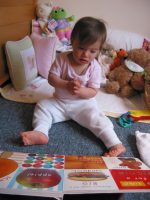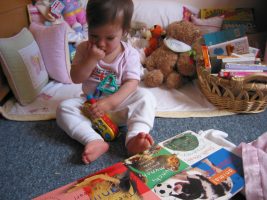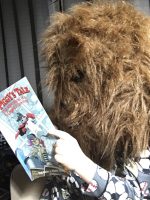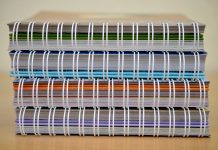
Even before my children have had head control, we have been reading with them. As babies, we read together before we put them down for a nap or for bed.

Once they could crawl, they knew to pick three books and bring them to our special reading spot. They would use baby signs to communicate with us about what they could see on the pages before they could speak any words. I still have “The Going to Bed Book” by Sandra Boynton solid in my head because we had a baby sign to use for something on almost every page.
When I hold a scratch-and-feel book that has been nibbled by my teething babies, it takes me back to holding that sweet wide-eyed baby cuddled up in a blanket on my lap. As a result, it is a painful for me to do Marie Kondo’s decluttering “book stage” of stacking, waking the books up and then thanking the books that someone else could use more than us.
The process is downright brutal when we get to my youngest child’s bookshelves as some of those books have been read in our family for over a decade.
Some use words like “Mum” as we bought them in London and loved them enough to ship them when we moved to Austin.
Okay, I’m wiping the tears now, but I will carry on.
Maybe this connection that we have started by routine since birth is why my children still request that we read together before bed – even in middle school.
My husband has read the Harry Potter series with both of my daughters, and now my 8-year old son is so excited that it is his turn. After all it is our family rule that you can’t watch the movies until you have read the book. The peer pressure amongst 8-year old boys to watch those movies is something fierce and a great motivator!
I have recently read “I am Malala” with my pre-teen. If you have a child who doesn’t like to go to school, I suggest that you co-read this. It was eye-opening for my daughter as Malala is roughly her age in the book, and Malala’s crusade was for her right to go to school. Goodness that was a helpful lesson for my daughter who doesn’t always look forward to Mondays.
Our technique of reading with our older children is the same that we have used since they were learning to read.
They read a page, and then we read a page. If I am uncertain if they have ever heard a certain word before, I ask them if they know what it means. We stop and talk about the story. Same stuff. Different age. I still love it as our conversations are now deeper than just “Do you think that the rabbit or the turtle is going to win the race?”
I feel that the cuddly connection factor is completely worth the reading routine in our house. Luckily, there are multiple statistics that also back the educational reason for doing so, too.
- Children who are read to at least three times a week by a family member are almost twice as likely to score in the top 25% in reading compared to children who are read to less than 3 times a week.
2. Books contain many words that children are unlikely to encounter frequently in spoken language. Books for kids actually contain 50%more words that children are unlikely to encounter frequently than regular conversation, TV or radio.

3. Students who choose what they read and have an informal environment in which to read tend to be more motivated, read more and show greater language and literacy development.
- Children’s academic successes at ages 9 and 10 can be attributed to the amount of talk they hear from birth through age 3. Young children who are exposed to certain early language and literacy experiences also prove to be good readers later on in life.
5. The National Center for Education Statistics (NCES) found that children who were read to frequently are also more likely to: count to 20, or higher than those who were not (60% vs. 44%), write their own names (54% vs. 40%), read or pretend to read (77% vs. 57%)
6. Higher reading exposure was 95% positively correlated with a growing region supporting semantic language processing in the brain.
7. The number of books in the home correlates significantly with higher reading scores for children.
It is this last statistic that will make me Marie Kondo my son’s bookshelf with a huge “Thank you from the deepest part of my heart” so that another child can have more books in their home.
A very loved stash of fantastic books is coming to a charity shop soon. I apologize, in advance, to the charity shop if any are over-loved and are not re-sellable. I just can’t bring myself to send them to landfill. Thank YOU for doing this for me if it is indeed necessary.











Love this! The instant I found out I was pregnant, I went to Barnes & Noble and dropped $500 on Childrens books! I adhered to the no TV or screen time before age 2. We became regulars at our library wherever we lived. No surprise, my son became a voracious reader. He also scored in the top 3% in the nation on his STAAR test last year.